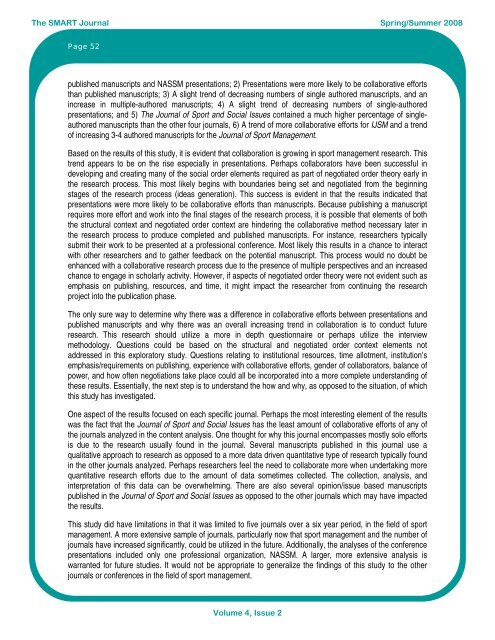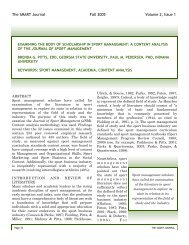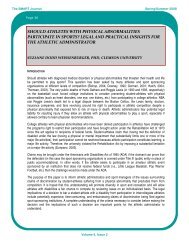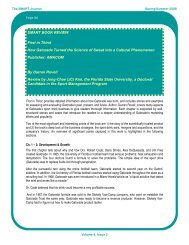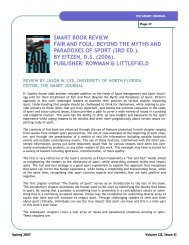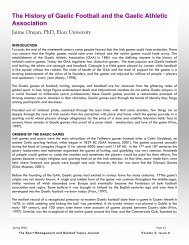Spring/Summer 2008 Volume 4, Issue 2 - The SMART Journal
Spring/Summer 2008 Volume 4, Issue 2 - The SMART Journal
Spring/Summer 2008 Volume 4, Issue 2 - The SMART Journal
Create successful ePaper yourself
Turn your PDF publications into a flip-book with our unique Google optimized e-Paper software.
<strong>The</strong> <strong>SMART</strong> <strong>Journal</strong> <strong>Spring</strong>/<strong>Summer</strong> <strong>2008</strong><br />
Page 52<br />
published manuscripts and NASSM presentations; 2) Presentations were more likely to be collaborative efforts<br />
than published manuscripts; 3) A slight trend of decreasing numbers of single authored manuscripts, and an<br />
increase in multiple-authored manuscripts; 4) A slight trend of decreasing numbers of single-authored<br />
presentations; and 5) <strong>The</strong> <strong>Journal</strong> of Sport and Social <strong>Issue</strong>s contained a much higher percentage of singleauthored<br />
manuscripts than the other four journals, 6) A trend of more collaborative efforts for IJSM and a trend<br />
of increasing 3-4 authored manuscripts for the <strong>Journal</strong> of Sport Management.<br />
Based on the results of this study, it is evident that collaboration is growing in sport management research. This<br />
trend appears to be on the rise especially in presentations. Perhaps collaborators have been successful in<br />
developing and creating many of the social order elements required as part of negotiated order theory early in<br />
the research process. This most likely begins with boundaries being set and negotiated from the beginning<br />
stages of the research process (ideas generation). This success is evident in that the results indicated that<br />
presentations were more likely to be collaborative efforts than manuscripts. Because publishing a manuscript<br />
requires more effort and work into the final stages of the research process, it is possible that elements of both<br />
the structural context and negotiated order context are hindering the collaborative method necessary later in<br />
the research process to produce completed and published manuscripts. For instance, researchers typically<br />
submit their work to be presented at a professional conference. Most likely this results in a chance to interact<br />
with other researchers and to gather feedback on the potential manuscript. This process would no doubt be<br />
enhanced with a collaborative research process due to the presence of multiple perspectives and an increased<br />
chance to engage in scholarly activity. However, if aspects of negotiated order theory were not evident such as<br />
emphasis on publishing, resources, and time, it might impact the researcher from continuing the research<br />
project into the publication phase.<br />
<strong>The</strong> only sure way to determine why there was a difference in collaborative efforts between presentations and<br />
published manuscripts and why there was an overall increasing trend in collaboration is to conduct future<br />
research. This research should utilize a more in depth questionnaire or perhaps utilize the interview<br />
methodology. Questions could be based on the structural and negotiated order context elements not<br />
addressed in this exploratory study. Questions relating to institutional resources, time allotment, institution’s<br />
emphasis/requirements on publishing, experience with collaborative efforts, gender of collaborators, balance of<br />
power, and how often negotiations take place could all be incorporated into a more complete understanding of<br />
these results. Essentially, the next step is to understand the how and why, as opposed to the situation, of which<br />
this study has investigated.<br />
One aspect of the results focused on each specific journal. Perhaps the most interesting element of the results<br />
was the fact that the <strong>Journal</strong> of Sport and Social <strong>Issue</strong>s has the least amount of collaborative efforts of any of<br />
the journals analyzed in the content analysis. One thought for why this journal encompasses mostly solo efforts<br />
is due to the research usually found in the journal. Several manuscripts published in this journal use a<br />
qualitative approach to research as opposed to a more data driven quantitative type of research typically found<br />
in the other journals analyzed. Perhaps researchers feel the need to collaborate more when undertaking more<br />
quantitative research efforts due to the amount of data sometimes collected. <strong>The</strong> collection, analysis, and<br />
interpretation of this data can be overwhelming. <strong>The</strong>re are also several opinion/issue based manuscripts<br />
published in the <strong>Journal</strong> of Sport and Social <strong>Issue</strong>s as opposed to the other journals which may have impacted<br />
the results.<br />
This study did have limitations in that it was limited to five journals over a six year period, in the field of sport<br />
management. A more extensive sample of journals, particularly now that sport management and the number of<br />
journals have increased significantly, could be utilized in the future. Additionally, the analyses of the conference<br />
presentations included only one professional organization, NASSM. A larger, more extensive analysis is<br />
warranted for future studies. It would not be appropriate to generalize the findings of this study to the other<br />
journals or conferences in the field of sport management.<br />
<strong>Volume</strong> 4, <strong>Issue</strong> 2


